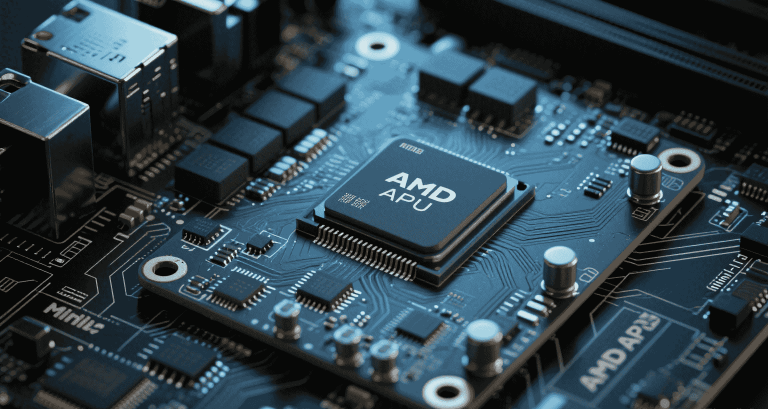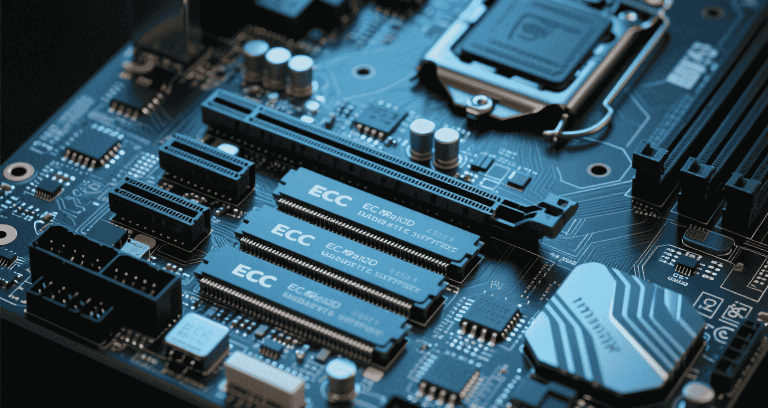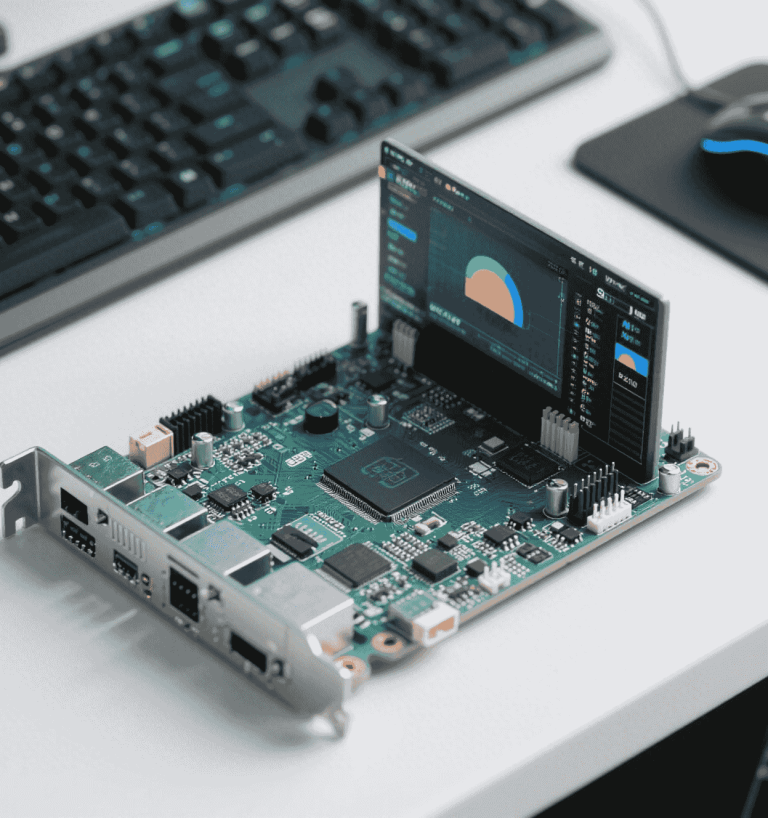إنتل سيليرون N150: تحقيق التوازن بين الطاقة والأداء والكفاءة العملية في الأنظمة المدمجة
جدول المحتويات
- 1. Introduction: The Role of the N150 in Modern Embedded Platforms
- 2. CPU Microarchitecture and Platform Integration
- 3. Thermal Design and Power Consumption in Real Deployments
- 4. System Performance vs Value Consideration
- 5. Graphics & Multimedia Capabilities
- 6. Memory and Storage Architecture
- 7. Peripheral and I/O Capabilities
- 8. Deployment Scenarios and Performance Feedback
- 9. BIOS Optimization and Embedded Tuning
- 10. Final Recommendations and Future Transition Paths
- المراجع والمزيد من القراءة
H2 1. Introduction: The Role of the N150 in Modern Embedded Platforms
For engineers building compact, quiet, and resilient systems, the Intel Celeron N150 remains a practical baseline. It sits at the intersection of cost control, low-power operation, and “good enough” compute for panel PCs, kiosks, thin clients, and light automation. While it is not a new SoC by 2025 standards, its maturity, broad OS support, and straightforward board integration still make it relevant for long-tail deployments and service contracts.
H3 1.1 Positioning Between Legacy Braswell and Alder Lake-N
N150—representative of the Braswell era—predates modern Alder Lake-N designs such as N100/N200. In practice, it offers predictable behavior, stable drivers, and a conservative thermal envelope. Where bleeding-edge efficiency isn’t mandatory, the N150’s familiarity across vendors and toolchains can reduce project risk and accelerate certification timelines.
H3 1.2 Intended Market Segments: Digital Signage, POS, Thin Clients
The SoC’s strengths align with fixed-function and light interactive workloads: digital signage with 1080p playback, browser-based POS, terminal services, and kiosk UIs. It can also underpin medical carts or test fixtures where determinism, long uptime, and spare parts availability matter more than raw throughput.
H3 1.3 Key Considerations for Hardware Engineers and System Integrators
- Plan for modest headroom: burst clocks are limited; avoid CPU-bound UI stacks.
- الاستخدام mature chipsets and proven cooling inside sealed or semi-sealed enclosures.
- Prioritize stable PSUs at low loads; efficiency curve matters at 10–20 W draw.
H2 2. CPU Microarchitecture and Platform Integration
The N150 class is rooted in Intel’s 14 nm Braswell lineage. You get a compact SoC with CPU cores, GPU, memory controller, and platform I/O on-die. The goal is simple: shrink board area and reduce component count to streamline Mini-ITX and embedded designs.
H3 2.1 Dual-Core Design Based on 14 nm Braswell Architecture
In typical implementations, the N150 provides two energy-sipping CPU cores with modest caches and conservative burst behavior. This favors consistent thermals over performance spikes—useful for systems installed in cabinets, kiosks, and fanless housings.
H3 2.2 Integrated GPU, PCH, and Memory Controller on SoC
Consolidation reduces board complexity: no external PCH, fewer power rails, fewer high-speed links to route. The simpler stack equates to easier EMI management and shorter bring-up cycles, particularly on 4-layer PCBs.
H3 2.3 SoC Advantages: BOM Simplification, Footprint Reduction
| Design Element | Discrete PC Platform | N150-class SoC Platform |
|---|---|---|
| مجموعة الشرائح | External PCH + heatsink | Integrated on-die |
| Board Layers | 6–8 layers typical | 4 layers feasible |
| Power Rails | Multiple VRMs | Fewer rails, simpler VRM |
| EMI/Compliance | More high-speed links | Fewer aggressors to tame |
H2 3. Thermal Design and Power Consumption in Real Deployments
Nameplate TDP tells only part of the story. In cabinets or passive enclosures, PSU efficiency, VRM losses, and storage choices dominate the real power number you’ll measure at the wall.
H3 3.1 TDP vs Reality: 6 W Nominal vs ~12 W Measured Idle
Many field builds idle around 10–14 W with one NVMe or SATA SSD attached. Add radios, sensors, or USB hubs, and idle can creep upward. This is acceptable for 24/7 nodes but must be included in thermal budgets.
H3 3.2 PSU Impact: Efficiency with PicoPSU vs SFX vs Barrel
At sub-20 W, PSU selection is critical. A compact SFX-Gold may run below its sweet spot and waste power. A quality DC brick + DC-DC board (PicoPSU-class) often outperforms ATX units at these loads—provided inrush and transient behavior are handled.
H3 3.3 Yearly Power Cost Modeling for Always-On Scenarios (~€25–40/year)
| Average Power | kWh/year | € at €0.25/kWh | الملاحظات |
|---|---|---|---|
| 10 W | 87.6 | €21.9 | Fanless kiosk, NVMe |
| 15 W | 131.4 | €32.9 | +Wi-Fi & 2× USB |
| 20 W | 175.2 | €43.8 | +2.5″ HDD or LTE modem |
H2 4. System Performance vs Value Consideration
You are trading top-end performance for predictable thermals and longevity. The question is not “Can it beat a modern E-core?” but “Does it meet the workload envelope with comfortable headroom?”
H3 4.1 N150 vs N100: Only ~5% Performance Increase
Against modern N100 (Alder Lake-N), N150 sits behind in IPC, clocks, and media blocks. If you can source N100 at similar cost, it is almost always the more efficient choice. If your program has legacy dependencies or qualification tied to N150-era platforms, the calculus changes.
H3 4.2 Performance-per-Watt Evaluation: GIPS/Watt Ratios
Rule of thumb: if your steady-state utilization exceeds ~60% on N150 during validation, you are under-provisioned. Move up a tier (N100/N200) or slim the workload.
H3 4.3 Scenarios Where Performance Gains Are Justified
- HTML5 signage with animations or multi-zone 1080p.
- VDI thin clients with dual 1080p monitors.
- Security overlays (browser hardening, EDR agents) on top of kiosk OS.
H2 5. Graphics & Multimedia Capabilities
The integrated GPU (Gen8 HD Graphics class in typical N150 designs) handles basic decode and display. It supports practical signage and HTPC-lite roles but is not a dedicated media engine by modern standards.
H3 5.1 Intel Gen8 HD Graphics with AV Codec Support
Expect hardware acceleration for H.264 and HEVC decode at 1080p. Software paths can supplement where codecs aren’t fully offloaded, but this increases CPU load and heat.
H3 5.2 Multimedia Limitations: No Dolby Vision, HDR10+, 3D MVC
Advanced HDR stacks and 3D formats aren’t target features. If HDR-critical, select a newer SoC or a discrete media device.
H3 5.3 LibreELEC and HTPC Tests in Mini-PCs
With lightweight skins and proper VAAPI configuration, 1080p playback is smooth. 4K decode is not recommended; downscale at the source or transcode upstream.
H2 6. Memory and Storage Architecture
Memory bandwidth and storage thermals dominate perceived responsiveness in kiosk and thin-client flows. Get these right and the system “feels faster” without changing the CPU.
H3 6.1 DDR3L/LPDDR3 Support and Bandwidth Constraints
Dual-channel is preferred when available, but many boards wire single-channel for cost/space. Use the highest validated frequency, and favor low-latency SODIMMs for small wins that add up.
H3 6.2 No ECC Memory Support: Suitability for Non-Mission-Critical Use
For storage appliances requiring end-to-end data integrity (e.g., ZFS with scrub targets), migrate to platforms with ECC UDIMM support. For signage and kiosk profiles, non-ECC is acceptable with good QA.
H3 6.3 eMMC, SATA, and PCIe Expansion for Embedded Storage
| Storage Option | الإيجابيات | السلبيات | Recommendation |
|---|---|---|---|
| eMMC | Low power, soldered, shock-resistant | Lower endurance, slower | Good for kiosk OS images |
| 2.5″ SATA SSD 2.5″ | Cooler, predictable, easy to service | Cabling, space | Great for signage & thin clients |
| NVMe (PCIe x2/x4) | Fast, compact | Can run hot in fanless chassis | Use with heatsink, throttle aware |
H2 7. Peripheral and I/O Capabilities
N150-class boards expose the essentials for embedded: USB, GPIO/UART, and panel display links (LVDS/eDP). The intent is stable device bring-up rather than exotic expandability.
H3 7.1 USB 3.0, GPIO, UART, SDIO for Peripheral Control
USB 3.0 handles cameras, barcode readers, and hubs. GPIO/UART/SDIO support control planes for button pads, card readers, or small radios. Validate EMI with shielded cables in noisy bays.
H3 7.2 Display Interfaces: HDMI, LVDS, eDP for Panel Integration
Many embedded ITX boards include LVDS/eDP headers for direct-drive panels. Follow panel vendor signal and power sequencing precisely; add ESD protection on long runs.
H3 7.3 I/O Limitations in High-Throughput Applications
If you need multiple high-lane PCIe devices, move to newer platforms; N150 designs rarely offer robust PCIe expandability without trade-offs.
H2 8. Deployment Scenarios and Performance Feedback
The best results come from matching the workload to the SoC’s strengths: predictable 2D UI, steady decode, and low-duty networking.
H3 8.1 POS, Kiosk, and Thin Client Use Cases
- POS: Browser-based front-ends with local printing and barcode USB.
- Kiosk: Full-screen kiosk mode with watchdog resets and remote content syncs.
- Thin client: RDP/PCoIP/Browser remoting at 1080p dual displays.
H3 8.2 Fanless Mini-PCs in HomeLab and Small Office Applications
As an always-on controller (Home Assistant, small MQTT broker, signage scheduler), N150 is stable and quiet. Limit background container churn; prefer long-running lightweight services.
H3 8.3 GMKtec G3 Plus and Similar Devices: Build Quality and Heat Dissipation
Many mini-PCs reuse similar chassis thermal designs. Always test under warm ambient with case closed for an hour; log CPU, SSD, and VRM temps before field deployment.
H2 9. BIOS Optimization and Embedded Tuning
Firmware choices shape idle draw and longevity. Set conservative boost behavior, predictable fans (if any), and aggressive sleep states.
H3 9.1 PL1/PL2 Behavior and Clock Management
Keep PL1 near nominal thermal capacity and limit PL2 burst duration to avoid heat soak in passive housings. Validate under worst-case ambient.
H3 9.2 Sleep States, ASPM, and C-State Optimization for Efficiency
# Linux (root): enable aggressive power save
powertop --auto-tune
# Persist ASPM where supported
echo powersave | sudo tee /sys/module/pcie_aspm/parameters/policy
# Verify device power states
sudo powertop --time=60 --html=report.html
H3 9.3 Boot-Time Behavior and Linux Compatibility
Most N150 boards boot cleanly with modern kernels (Ubuntu LTS, Debian). For kiosk OS, disable unused buses (e.g., unused SATA) and fast-fail missing devices to shave seconds off boot.
H2 10. Final Recommendations and Future Transition Paths
N150 delivers when the job is constant, light, and reliability-first. For new designs with higher graphics needs or tighter energy targets, consider N100/N200/N305 or ARM alternatives—but keep N150 in mind for sustaining projects and drop-in replacements.
H3 10.1 When to Use the N150 vs N100 or N305
- اختر N150 for legacy-qualified kiosks, POS, simple signage.
- اختر N100/N200 for better PPW and modern media features.
- اختر N305 when extra cores are needed for multitasking nodes.
H3 10.2 Lifecycle Concerns: Driver Support, OS Compatibility
Confirm vendor BIOS maintenance windows. Maintain your own driver mirror and image rebuild process to mitigate upstream attrition.
H3 10.3 Transition Planning for Alder Lake-N or ARM Alternatives
- Freeze board interface spec (display, USB, GPIO) for forward-compatibility.
- Abstract device access in software to ease SoC migration.
- Pilot dual builds (N150 and N100) to de-risk transition before a hard cutover.



